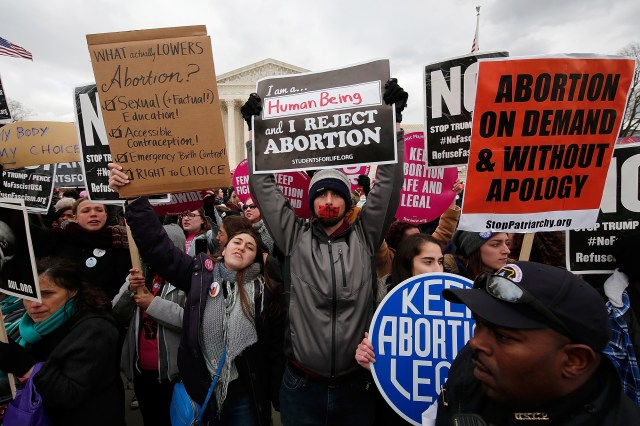45 years after Roe v. Wade the culture war over abortion rages on in America (Credit Image: Win McNamee/Getty Images)

If you’re an avid watcher of French crime drama Spiral, you’ll know that detective Laure Berthaud had an unexpected pregnancy and found that, at 15 weeks, she wasn’t permitted under French law to have an abortion. Before deciding to go ahead with the pregnancy, she considered travelling to another country in Europe for a termination, because the rules are different in each place.
That’s part of the problem, when it comes to trying to establish what people really think about abortion. The variance in term limits from country to country[1. It’s important to remember there is a rich/poor divide here, and the developing world comes off worst. The World Health Organisation estimate that 25 million unsafe abortions are carried out each year, 97% of which are in developing countries in Africa, Asia and Latin America.] means that is difficult to decide what is meant when the legality of abortion is discussed. It effectively means different things in different places – and without a level playing field it’s impossible to compare levels of public support. The debate is further complicated by people voting with their feet: expressing their disapproval of a strict legislative regime by travelling elsewhere.
At a federal level, the Roe vs Wade ruling – 45 years ago this week – was intended to put an end to the debate by making abortion legal throughout the United States.
It didn’t work. Availability of abortion in the US – along with requirements for counselling and ultrasound, and access to public funding – varies from state to state, creating at national level the situation Europeans find themselves in across the continent.
And while the American public is marginally more supportive than not of abortion’s legality, with 57 % in favour, 40 % still think it should be illegal. Data gathered by Pew Research Center shows that many religious groups still feel strongly that it should be mostly illegal. The more evangelical groups, many of whose members voted Trump into office, are more likely to say that abortion should not be legally available.
But members of the Episcopal Church and United Church of Christ would support it, as would 83 % of American Jews, according to the Religious Landscape study of 2014. There may be official doctrines held by religious groups, but that doesn’t mean all believers will subscribe to them. And this disparity was writ large when it came to the 2016 Presidential election: a vacancy on the Supreme Court focused much of the electoral campaigns onto the issue, and it became a deal-breaker for many people.

So, the debate rages on. The Atlantic’s Emma Green reported last week that many in the anti-abortion movement claim that science is on their side. Medical advances, they say, have improved viability outside the womb – an argument they have used to draw attention to the debate about term limits. Science is drafted in to support a point of view, and to propagate a particular moral argument.
In Britain, our debate is in a very different place, and that’s reflected in research: ComRes research found that 72% of adults say that the practice of abortion should be governed by law, so we appear to have consensus that this procedure is different to most other medical interventions and requires legal scrutiny.
But when presented with the difference in term limits between Great Britain (24 weeks) and most other EU countries (12 weeks or lower), 60% said that term limits in Britain should be reduced. We don’t appear to be keen on the issue Berthaud faced, and would rather have some consistency with our global neighbours.
Yet if we look at informal barometers of public opinion – take middle-class popular culture, for example – we seem to accept that abortion is a reality in family life. In the last six months, queen of women’s fiction Marian Keyes’ published her latest novel The Break, and the UK’s TV drama Cold Feet broadcast its seventh series. Both carried storylines of teenage women being supported by their parents and (although somewhat reluctantly, in Cold Feet) their boyfriends to terminate an unwanted pregnancy. Both are written in a style which celebrates human relationship and supportive families. It’s seen as sad, but acceptable, in a “we can get through this” way.
By way of contrast, back in the US, the culture wars rage on. American novelist Leni Zumas has just published a dystopian novel, Red Clocks, in which abortion is criminalised and a Pink Wall prevents women from travelling to Canada to terminate a pregnancy. Roe vs Wade may have attempted to close the issue in the US, but it’s as polarising as it ever was.










Join the discussion
Join like minded readers that support our journalism by becoming a paid subscriber
To join the discussion in the comments, become a paid subscriber.
Join like minded readers that support our journalism, read unlimited articles and enjoy other subscriber-only benefits.
Subscribe